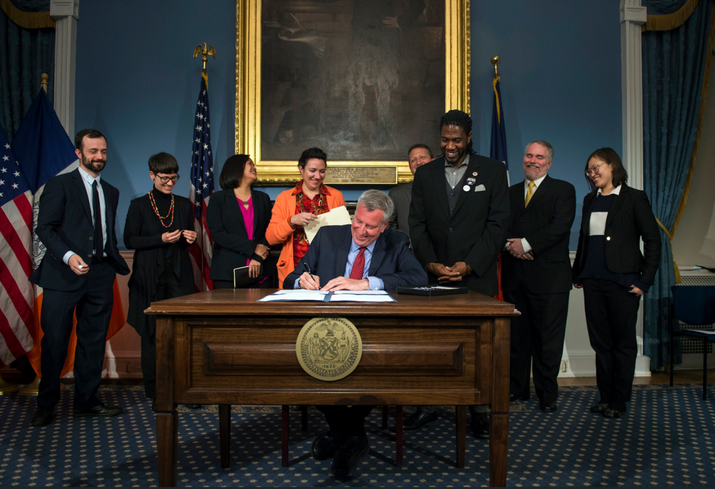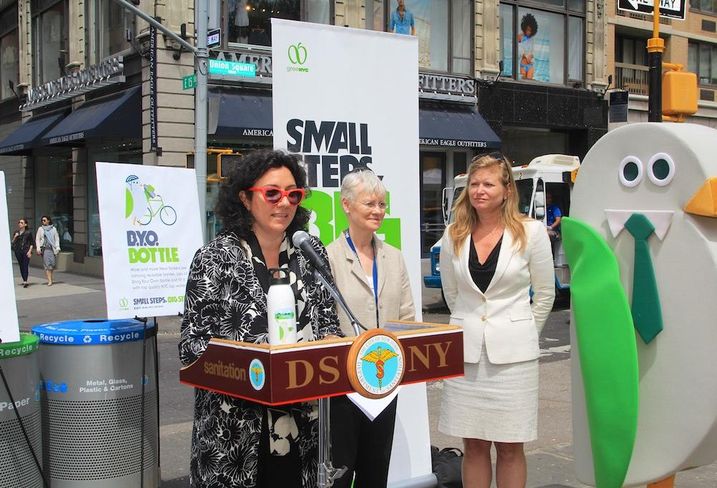Q&A: NYC Mayor’s Office of Sustainability Director Nilda Mesa
In an office market where sustainability figures increasingly into tenants’ wish lists, we can be sure it’ll play a huge role in the future of commercial real estate. We caught up with Nilda Mesa, director of the Mayor’s Office of Sustainability and a speaker at our Future of Real Estate event next week, to get her take on where things are headed.
Bisnow: Can you explain the Mayor’s “80 by 50” plan and say a bit about your office’s role in it?
Nilda: In September 2014, Mayor de Blasio announced a plan to reduce greenhouse emissions 80% by the year 2050. When this goal was announced, the city’s roughly 1 million buildings accounted for about 70% of emissions citywide, which is a much greater share of greenhouse gas emissions than in other cities.
Bisnow: So what's next?
Nilda: Tomorrow we are releasing the Buildings Technical Working Group report, and it will have a lot more information. We took a deep dive into building data and what works and what doesn’t for how our buildings can operate more efficiently, and the report goes into all of it. No other city has done a deep dive of this kind around greenhouse gas emissions.
Also, right now, less than 2% of the city’s power grid comes from renewable sources, so changing how we get our power will be an increasingly big part of it. Last summer we issued an RFI to find out how we might be able to procure 100% renewably sourced electricity for the city’s municipal operations, to help come up with ways to get more renewable energy into the city grid.
Bisnow: What are some of the key ways the commercial real estate industry can play a part cutting emissions in the city?
Nilda: The industry can do all kinds of things. We launched the NYC Retrofit Accelerator last September to help building owners navigate the process of making their buildings more efficient.
We also have an energy and water performance map on our website. Building owners or anyone else can use it to see how a building compares to other buildings in the city. It’s based on data we collect from building owners on energy and water performance.
When it comes time to look at the planning cycle for a building, that’s a great time to use these tools to see if an energy-efficiency measure can be built into planning.
We’ve also noticed that oftentimes commercial tenants’ energy cost is built into their rent so they don’t know how much they’re using. The goal is to bring incentives into alignment with where the biggest energy uses actually are. We’re preparing to launch a carbon challenge that will help and tenants and landlords jointly tackle this issue.
Bisnow: Are there some initiatives you've seen in other cities—globally or domestically—that provide models for operating and developing real estate sustainably here in NYC?
Nilda: One thing we’ve been looking at is what Brussels is doing with new buildings. They have a code that requires ultra-low energy design and high performance.
A lot of emphasis is placed on integrating the building design itself into the whole energy performance of a building, making it holistic instead of what is typically done, which is to treat systems as separate. This includes considering the façade, making sure seals around windows are tight, and other details to keep heat and energy from escaping when it’s not supposed to.
We think that idea has real promise in NYC. We’re involved in all kinds of city networks to see what other cities are doing. Seattle, Boulder, Portland and others are good examples. We’re always looking at what others do, and they look at what we do, too. We all learn from each other. It’s all new.
Bisnow: What are some things we can expect 10, 20 years from now, in terms of commercial landlords changing the ways they build and operate buildings?
Nilda: I think we’ll be looking at buildings in more of a holistic, performance-based way, not so much as separate systems. New technology is part of this, but it’s also building design. It means looking at the building as part of the solution.
I think we’ll see more data tools that will help people make decisions on when they want to use energy. Solar power’s been a huge area of growth and I think that will continue. I hope a lot more renewable energy goes into the grid. And there’s a big potential for things like geothermal power, which is a big capital investment up front but can really pay off. Data will be a big driver in all of this.
For example, CO2 censors can now figure out how many people are in a space and calibrate what temperature it should be, instead of blindly setting a thermostat.
But there’s also a lot of low-tech solutions. As I mentioned above, we’d like to see leases written in a way that treats energy usage as an expense tenants have some control over. Submetering would let tenants and landlords see exactly how much energy is being used. We go into much of this in the report that comes out tomorrow.
Bisnow: What drives you to do this work?
Nilda: I think my answer today is different than when I first started. Today, as a longtime Harlem resident, I can see the impact a place that’s not necessarily environmentally friendly can have on residents; Everything from higher heating bills for folks who can’t easily afford it, to air quality. Asthma is the No. 1 reason kids miss school days.
Communities that can least afford it get hit the hardest. A big thing that’s changed about how I look at why I do what I do is having kids. I now realize I can’t fix everything, which isn’t what my 20-something self thought. Now it’s more about leaving things better than how I found them, for the next generation.
You can hear more from Nilda at Bisnow's Future of Real Estate on Tuesday, April 26 at the Highline Hotel, starting at 3:30pm. Sign up here.



